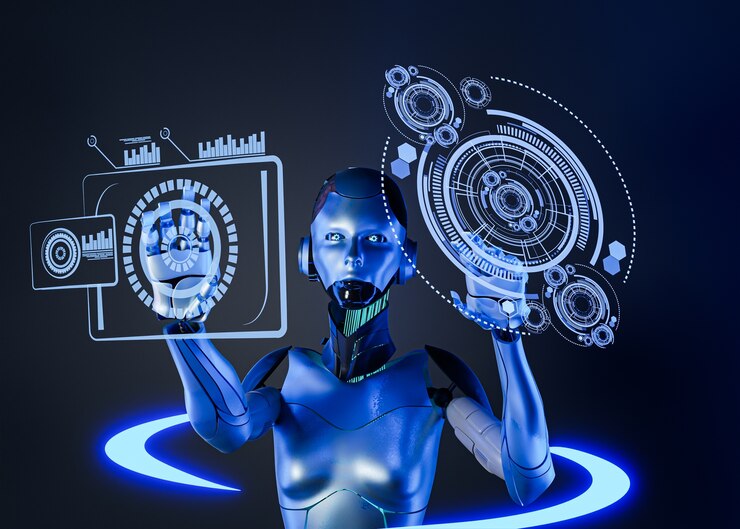Artificial Intelligence (AI) has transformed from a theoretical concept to a cornerstone of modern technology, reshaping industries and everyday life. Rooted in the desire to create machines that mimic human intelligence, AI has evolved significantly over decades. This article traces the journey of AI, from its origins to its present advancements, and explores its future potential across various domains.
1. The Origins of Artificial Intelligence
The idea of artificial intelligence dates back centuries, with early philosophers and mathematicians pondering the possibility of machines that could think like humans.
a. Early Inspirations
- Ancient Myths and Automata: Myths from ancient Greece, such as the story of Talos, a mechanical man, reflect early fascination with intelligent machines.
- Mathematical Foundations: In the 19th century, Charles Babbage and Ada Lovelace conceptualized the Analytical Engine, an early precursor to programmable computers.
b. The Birth of AI (1950s)
- Alan Turing’s Contributions: Alan Turing’s 1950 paper, “Computing Machinery and Intelligence,” introduced the concept of machine intelligence and the Turing Test.
- The Dartmouth Conference (1956): Regarded as the birth of AI as a field, this conference brought together pioneers like John McCarthy and Marvin Minsky to explore the potential of intelligent machines.
2. Early Developments and Challenges
The initial decades of AI research were marked by both groundbreaking discoveries and significant challenges.
a. Symbolic AI and Rule-Based Systems
- Early AI systems relied on symbolic reasoning and if-then rules to mimic human thought processes.
- Applications: These systems excelled in tasks like chess-playing (e.g., IBM’s Deep Blue) and basic natural language processing.
b. Limitations
- Computational Power: Early computers lacked the processing power to handle complex AI models.
- Data Scarcity: AI systems required large datasets, which were not readily available.
- Overpromising: The AI winters of the 1970s and 1980s were caused by unmet expectations and funding cuts.
3. The Rise of Machine Learning
The 1990s and 2000s saw a paradigm shift from symbolic AI to machine learning (ML), a subset of AI that focuses on enabling machines to learn from data.
a. Introduction to Machine Learning
- Algorithms: ML introduced algorithms like decision trees, support vector machines, and neural networks.
- Applications: Spam filters, recommendation systems, and fraud detection systems emerged as practical applications.
b. Big Data and Improved Computing Power
- The explosion of digital data and advancements in computing hardware enabled more sophisticated ML models.
- Cloud Computing: Platforms like Amazon Web Services (AWS) made large-scale AI experiments feasible.
c. Deep Learning Revolution (2010s)
- Neural Networks: Inspired by the human brain, deep neural networks brought breakthroughs in image and speech recognition.
- Major Milestones:
- Google’s AlphaGo defeating a world champion in Go (2016).
- ImageNet’s competition spurring advancements in computer vision.
4. The Current State of AI
Today, AI has become integral to many aspects of life, driven by advancements in algorithms, data availability, and hardware.
a. Key Technologies
- Natural Language Processing (NLP): AI models like GPT (Generative Pre-trained Transformer) enable human-like text generation and understanding.
- Computer Vision: AI powers facial recognition, autonomous vehicles, and medical imaging.
- Robotics: AI enables robots to perform complex tasks in manufacturing, healthcare, and exploration.
- Reinforcement Learning: Systems learn optimal actions through trial and error, as seen in self-driving cars and gaming AI.
b. Industry Applications
- Healthcare: AI assists in diagnostics, drug discovery, and personalized medicine.
- Finance: Fraud detection, algorithmic trading, and risk assessment rely heavily on AI.
- Retail: AI enhances customer experiences through chatbots, personalized recommendations, and inventory management.
- Education: Adaptive learning platforms and virtual tutors use AI to cater to individual student needs.
c. Ethical and Societal Implications
- Bias in AI: Algorithms can perpetuate existing biases if trained on unrepresentative data.
- Privacy Concerns: AI-driven surveillance raises concerns about data misuse.
- Job Displacement: Automation threatens traditional roles while creating demand for AI-related skills.
5. Future Trends and Predictions
a. AI Democratization
- Open-source tools and platforms are making AI accessible to businesses and individuals.
- Low-Code AI: Simplified interfaces enable non-experts to build AI solutions.
b. AI and Human Collaboration
- AI will augment human capabilities rather than replace them, enhancing creativity and decision-making.
c. Advanced AI Models
- Generative AI: Models like DALL-E and ChatGPT are paving the way for creative applications in art, writing, and design.
- General AI: Research is progressing towards AI systems capable of performing tasks across diverse domains.
d. AI in Sustainability
- AI will play a pivotal role in tackling global challenges such as climate change and resource management.
- Smart Grids: AI optimizes energy distribution and consumption.
- Environmental Monitoring: AI-powered sensors track pollution and biodiversity.
e. Regulation and Governance
- Governments and organizations are working on frameworks to ensure ethical AI deployment.
- Transparency: Explainable AI (XAI) aims to make AI decisions understandable to humans.
6. Challenges and Considerations
a. Ethical Dilemmas
- Ensuring fairness and reducing bias in AI systems remains a critical challenge.
b. Cybersecurity Risks
- AI’s capabilities can be exploited for malicious purposes, such as deepfakes and automated hacking.
c. Dependence on AI
- Overreliance on AI systems could lead to vulnerabilities if these systems fail.
d. Education and Workforce Transformation
- Preparing the workforce for an AI-driven economy requires significant investments in education and upskilling.
7. Conclusion
The evolution of artificial intelligence has been marked by remarkable achievements and transformative impacts. From its humble beginnings in theoretical discussions to its present role in shaping industries, AI continues to push the boundaries of what is possible. As we look to the future, responsible innovation, ethical considerations, and global collaboration will be key to harnessing AI’s potential for the benefit of humanity. By understanding its evolution and embracing its possibilities, we can ensure that AI becomes a force for good in an increasingly complex world.
Tags: Artificial intelligence